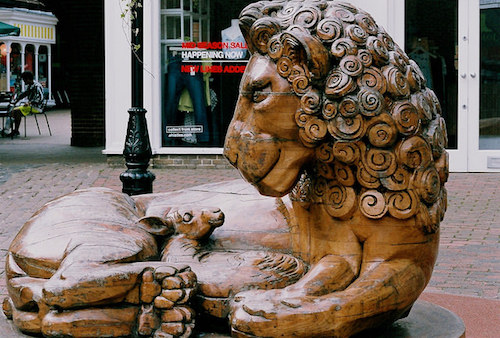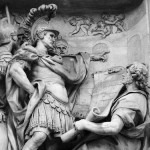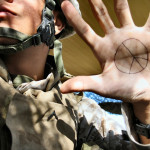We run our website the way we wished the whole internet worked: we provide high quality original content with no ads. We are funded solely by your direct support. Please consider supporting this project.

A Non-Violent Creation
A biblical teaching that we often overlook regarding the centrality of non-violence concerns God’s original vision of creation. We have grown so accustomed to the violence we experience as a part of nature that we don’t even question whether it is supposed to be the way it is. However when we see God’s vision for nature and vision of what the world will be like once it’s freed from the principalities and the powers, then it becomes obvious how foundational the call to non-violence is. In Genesis 1:29-30 we find the Lord telling the original humans:
I give you every seed–bearing plant on the face of the whole earth and every tree that has fruit with seed in it. They will be yours for food. And to all the beasts of the earth and all the birds in the sky and all the creatures that move on the ground—everything that has the breath of life in it—I give every green plant for food (emphasis added).
According to this passage, God gave “every green plant “ to every living thing for food. He did not give animals to each other, or to humans, for food. The original “food chain”, it seems, was completely free of violence.
This point is reiterated in Genesis 2 when the Lord tells Adam he was “free to eat from any tree in the garden” (vs. 16-17, emphasis added) but does not say that Adam was free to eat any of the animals. Even after the fall God specifies that humans were to eat “the plants of the field,” despite the fact that they’d be more difficult to grow because of the curse that had come upon the land (Gen. 3:18-19). However literally or symbolically one interprets this aspect of the Genesis narrative, it clearly teaches that it was not God’s original ideal to produce a nature “red in tooth and claw” (Tennyson).
God’s non-violent ideal for creation is also expressed when God announces what creation will look like in the future when his Kingdom is fully established. Through Isaiah the Lord declares:
The wolf will live with the lamb,
the leopard will lie down with the goat,
the calf and the lion and the yearling together;
and a little child will lead them.
The cow will feed with the bear,
their young will lie down together,
and the lion will eat straw like the ox.
Infants will play near the hole of the cobra;
young children will put their hands into the viper’s nest.
They will neither harm nor destroy
on all my holy mountain,
for the earth will be filled with the knowledge of the LORD
as the waters cover the sea. (Isa 11:6-9. cf. Isa. 65:25; Hos. 2:18) .
Obviously, a world in which wolves and lambs get along and in which lions eat straw and children play with cobras is a world that operates by very different laws than our present one. Indeed, because the only nature we’ve ever experienced is the intrinsically violent one we find ourselves in, we have trouble imagining what a non-carnivorous wolf or lion or a non-poisonous copra would be like. But this shouldn’t surprise us since we have the same difficulty imagining what our resurrected bodies will be like.
It seems that when the reign of God is fully established on earth, the hostility that exists among animals and between animals and humans, will be brought to a complete end. Nature will no longer look like it’s crafted by a “roaring lion seeking whom he may devour” (I Pet. 5:8), but by a benevolent Creator who possesses the kind of character we find in Jesus. God’s ideal for creation, expressed in Genesis 1 and 2, will finally be attained. There will be a “new heaven and a new earth,” in which all suffering, violence and death will be eradicated (2 Pet 3:13; Rev. 21:1). The world will then be free of all elements of the curse, including thorn bushes and briers (Isa 55:13). God’s love and God’s peace will characterize everything. This demonstrates that the violence, death-filled nature we presently live in reflects the corruption of the principalities and powers of evil, not the ideal will of God.
Category: General
Tags: Creation, Non-Violence, Peace, Warfare Worldview
Topics: Enemy-Loving Non-Violence
Related Reading

You’re Not a Pacifist Are You?
Jayel Aheram via Compfight Brian Zahnd wrote a great piece the other day on this topic. He contends that when he is asked this question, it often has the same flavor of the question, “You’re not a pornographer are you?” Why is this question so contentious among believers? Brian has some interesting ideas about it.…

God’s Aikido Way of Defeating Evil
Greg continues his thoughts on the atonement with this installment highlighting the way God uses the evil intentions and actions of his enemies to bring about good. And because this strategy is based in love, the demons who encountered Christ could not possibly imagine what he was up to. They ended up participating in their…

Why Didn’t Jesus Denounce Military Service?
A common objection to the claim that Jesus and the authors of the New Testament were opposed to all forms of violence is that neither Jesus nor anyone else speaks out against it. When soldiers asked John the Baptist what they should do in response to his message, for example, he told them not to…

Where are the Blessed Peacemakers?
Religion Dispatches Magazine posted an article recently on embracing non-violence in the Christian tradition. In it, Elizabeth Drescher argues that the violent imagery in Paul’s writing accounts for a great deal of the violent posturing going on in churches today, but she also argues that these images have been misapplied and misunderstood. She challenges us…

ISIS, Islam & Jesus
http://youtu.be/7W5NWWFFJMg?list=PLB5r2P47beqLlY3wM6VKjwEEofXAZ4lX5 Our friend Bruxy taught a series at The Meeting House titled ISIS, Islam & Jesus that we wanted to share with you. This is episode one, and you can find the whole series by clicking here. If you believe in redemptive violence, you’ll be challenged by what he has to say.

What To Do with the Bible’s Talk of Satan
Recently, Roger Olson raised the question on his blog about why Satan is ignored in modern theology. He observed how Greg’s theology takes an “obvious, ‘up front,’ blatant belief in a very personal, very real, very active Satan who has great power in the world.” Because we often have so little to say about Satan…
